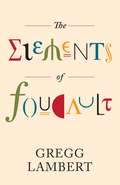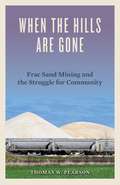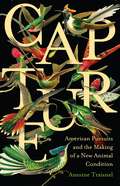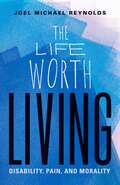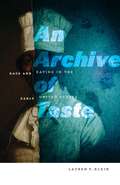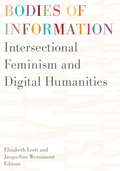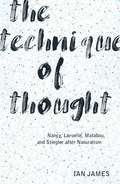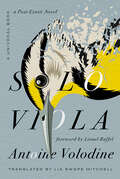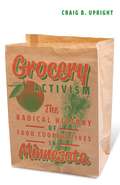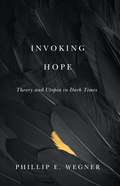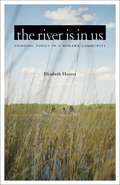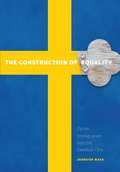- Table View
- List View
The Elements of Foucault (Posthumanities #55)
by Gregg LambertA new conceptual diagram of Foucault&’s original vision of the biopolitical order The history around the critical reception of Michel Foucault&’s published writings is troubled, according to Gregg Lambert, especially in light of the controversy surrounding his late lectures on biopolitics and neoliberal governmentality. In this book, Lambert&’s unique approach distills Foucault&’s thought into its most basic components in order to more fully understand its method and its own immanent rules of construction.The Elements of Foucault presents a critical study of Foucault&’s concept of method from the earlier History of Sexuality, Volume 1, to his later lectures. Lambert breaks down Foucault&’s post-1975 analysis of the idea of biopower into four elements: the method, the conceptual device (i.e., dispositif), the grid of intelligibility, and the notion of &“milieu.&” Taken together, these elements compose the diagram of Foucault&’s early analysis and the emergence of the neoliberal political economy. Lambert further delves into how Foucault&’s works have been used and misused over time, challenging the periodization of Foucault&’s later thought in scholarship as well as the major and most influential readings of Foucault by other contemporary philosophers—in particular Gilles Deleuze and Giorgio Agamben. The Elements of Foucault is the first generally accessible, yet rigorous and comprehensive, discussion of lectures and major published works of Foucault&’s post-1975 theory of biopower and of the major innovation of the concept of dispositif. It is also the first critical work to address the important influence of French philosopher Georges Canghuilhem on Foucault&’s thought.
The Silver Box: An Enchantment Lake Mystery
by Margi PreusIn the final Enchantment Lake mystery, Francie&’s search for the truth about her mother—and herself—plunges her into danger during a North Woods winter When she wakes in her aunts&’ cold cabin on the shore of Enchantment Lake, Francie remembers: everything about her life has changed. Or is about to. Or just might. Everything depends on the small, engraved silver box that she now possesses—if only she can follow its cryptic clues to the whereabouts of her missing mother and understand, finally, just maybe, the truth about who she really is. Francie, it turns out, has a lot to learn, and this time the lessons could be deadly. Her search for answers takes her and her best friends Raven and Jay as far afield as an abandoned ranch in Arizona and as close to home as a sketchy plant collector&’s conservatory and a musty old museum where shadows lurk around every display case. At the heart of it all is a crime that touches her own adopted North Woods: thieves dig up fragile lady&’s slippers, peel bark from birches, strip moss off trees, cut down entire forests of saplings to sell for home décor. But Francie is up against no ordinary plant theft. One ominous clue after another reveal that she possesses something so rare and so valuable that some people are willing to do anything to get it. When Francie&’s investigation leads her into the treacherously cold and snowy North Woods, she finds out that she too is being pursued.
When the Hills Are Gone: Frac Sand Mining and the Struggle for Community
by Thomas W. PearsonFracking is one of the most controversial methods of fossil fuel extraction in the United States, but a great deal about it remains out of the public eye. In Wisconsin it has ignited an unprecedented explosion in the state&’s sand mining operations, an essential ingredient in hydraulic fracturing that has shaken local communities to the core.In When the Hills Are Gone, Thomas W. Pearson reveals the jolting impact of sand mining on Wisconsin&’s environment and politics. A source of extraordinary wealth for a lucky few, and the cause of despoiled land for many others, sand mining has raised alarm over air quality, water purity, noise, blasting, depressed tourism, and damage to the local way of life. It has also spurred a backlash in a grassroots effort that has grown into a mature political movement battling a powerful mining industry.When the Hills Are Gone tells the story of Wisconsin&’s sand mining wars. Providing on-the-ground accounts from both the mining industry and the concerned citizens who fought back, Pearson blends social theory, ethnography, stirring journalism, and his own passionate point of view to offer an essential chapter of Wisconsin&’s history and an important episode in the national environmental movement. Digging deep into the struggles over place, community, and local democracy that are occurring across the United States, When the Hills Are Gone gives vital insight into America&’s environmental battles along the unexpected frontlines of energy development.
Capture: American Pursuits and the Making of a New Animal Condition
by Antoine TraisnelReading canonical works of the nineteenth century through the modern transformation of human–animal relations From Audubon&’s still-life watercolors to Muybridge&’s trip-wire locomotion studies, from Melville&’s epic chases to Poe&’s detective hunts, the nineteenth century witnessed a surge of artistic, literary, and scientific treatments that sought to &“capture&” the truth of animals at the historical moment when animals were receding from everyday view. In Capture, Antoine Traisnel reveals how the drive to contain and record disappearing animals was a central feature and organizing pursuit of the nineteenth-century U.S. cultural canon.Capture offers a critical genealogy of the dominant representation of animals as elusive, precarious, and endangered that came to circulate widely in the nineteenth century. Traisnel argues that &“capture&” is deeply continuous with the projects of white settler colonialism and the biocapitalist management of nonhuman and human populations, demonstrating that the desire to capture animals in representation responded to and normalized the systemic disappearance of animals effected by unprecedented changes in the land, the rise of mass slaughter, and the new awareness of species extinction. Tracking the prototyping of biopolitical governance and capitalist modes of control, Traisnel theorizes capture as a regime of vision by which animals came to be seen, over the course of the nineteenth century, as at once unknowable and yet understood in advance—a frame by which we continue to encounter animals today.
The Best Casserole Cookbook Ever
by Beatrice Ojakangas500 casseroles for every occasion—sweet and savory, hearty and light, homey and festive—from beloved James Beard Cookbook Hall of Famer Beatrice Ojakangas A good cook once said that a casserole is a blend of inspiration and what&’s on hand. Add to that a generous helping of know-how, and you&’ve got The Best Casserole Cookbook Ever. Call it a hotdish, covered dish, or casserole—in these pages, you&’ll find one-dish meals for every season and any occasion, put together with James Beard Cookbook Hall of Famer Beatrice Ojakangas&’s customary common sense and uncommon culinary flair. For breakfast, there are make-ahead strata and quiches or last-minute offerings like baked omelets and Eggs Florentine; for lunches and brunches, light fare or full-on midday meals; and for dinner a dizzying array of dishes, meaty or vegetarian, made with fresh ingredients or pantry staples—from Pork Chops with Apple Stuffing to Baked Spaghetti, Southwestern Beans, or Autumn Vegetable Stew. Leave room for dessert, because Ojakangas includes sweet casseroles like Mocha Fudge Pudding and Strawberry Rhubarb Crisp. And for appetizers and snacks there are dips, spreads, and slathers; mini quiches and omelet squares; and mushrooms au gratin, curried, or stuffed. You&’ll even find bread here in casserole form, from sweet Cinnamon Bubble Bread to savory Cornmeal Spoon Bread and tender Sally Lunn.With an ever-reliable and inspired sense of how to create a delicious meal, Ojakangas has advice for both expert and novice about ingredients, equipment, and meals. Combine that with whatever you have in the pantry and fridge, and this cookbook is the perfect guide to everything that a casserole might be.
The Life Worth Living: Disability, Pain, and Morality
by Joel Michael ReynoldsA philosophical challenge to the ableist conflation of disability and pain More than 2,000 years ago, Aristotle said: &“let there be a law that no deformed child shall live.&” This idea is alive and well today. During the past century, Supreme Court Justice Oliver Wendell Holmes Jr. argued that the United States can forcibly sterilize intellectually disabled women and philosopher Peter Singer argued for the right of parents to euthanize certain cognitively disabled infants. The Life Worth Living explores how and why such arguments persist by investigating the exclusion of and discrimination against disabled people across the history of Western moral philosophy. Joel Michael Reynolds argues that this history demonstrates a fundamental mischaracterization of the meaning of disability, thanks to the conflation of lived experiences of disability with those of pain and suffering. Building on decades of activism and scholarship in the field, Reynolds shows how longstanding views of disability are misguided and unjust, and he lays out a vision of what an anti-ableist moral future requires. The Life Worth Living is the first sustained examination of disability through the lens of the history of moral philosophy and phenomenology, and it demonstrates how lived experiences of disability demand a far richer account of human flourishing, embodiment, community, and politics in philosophical inquiry and beyond. Accessibility features: Retail e-book files for this title are screen-reader friendly with images accompanied by short alt text and/or extended descriptions.
Reading Autobiography Now: An Updated Guide for Interpreting Life Narratives, Third Edition
by Sidonie Smith Julia WatsonA user-friendly guide to reading, writing, and theorizing autobiographical texts and practices for students, scholars, and practitioners of life narrative The boom in autobiographical narratives continues apace. It now encompasses a global spectrum of texts and practices in such media as graphic memoir, auto-photography, performance and plastic arts, film and video, and online platforms. Reading Autobiography Now offers both a critical engagement with life narrative in historical perspective and a theoretical framework for interpreting texts and practices in this wide-ranging field. Hailed upon its initial publication as &“the Whole Earth Catalog of autobiography studies,&” this essential book has been updated, reorganized, and expanded in scope to serve as an accessible and contemporary guide for scholars, students, and practitioners. Sidonie Smith and Julia Watson explore definitions of life narrative, probe issues of subjectivity, and outline salient features of autobiographical acts and practices. In this updated edition, they address emergent topics such as autotheory, autofiction, and autoethnography; expand the discussions of identity, relationality, and agency; and introduce new material on autobiographical archives and the profusion of &“I&”s in contemporary works. Smith and Watson also provide a helpful toolkit of strategies for reading life narrative and an extensive glossary of mini-essays analyzing key theoretical concepts and dozens of autobiographical genres. An indispensable exploration of this expansive, transnational, multimedia field, Reading Autobiography Now meticulously unpacks the heterogeneous modes of life narratives through which people tell their stories, from traditional memoirs and trauma narratives to collaborative life narrative and autobiographical comics.
An Archive of Taste: Race and Eating in the Early United States
by Lauren F. KleinA groundbreaking synthesis of food studies, archival theory, and early American literature There is no eating in the archive. This is not only a practical admonition to any would-be researcher but also a methodological challenge, in that there is no eating—or, at least, no food—preserved among the printed records of the early United States. Synthesizing a range of textual artifacts with accounts (both real and imagined) of foods harvested, dishes prepared, and meals consumed, An Archive of Taste reveals how a focus on eating allows us to rethink the nature and significance of aesthetics in early America, as well as of its archive.Lauren F. Klein considers eating and early American aesthetics together, reframing the philosophical work of food and its meaning for the people who prepare, serve, and consume it. She tells the story of how eating emerged as an aesthetic activity over the course of the eighteenth century and how it subsequently transformed into a means of expressing both allegiance and resistance to the dominant Enlightenment worldview. Klein offers richly layered accounts of the enslaved men and women who cooked the meals of the nation&’s founders and, in doing so, directly affected the development of our national culture—from Thomas Jefferson&’s emancipation agreement with his enslaved chef to Malinda Russell&’s Domestic Cookbook, the first African American–authored culinary text.The first book to examine the gustatory origins of aesthetic taste in early American literature, An Archive of Taste shows how thinking about eating can help to tell new stories about the range of people who worked to establish a cultural foundation for the United States.
Bodies of Information: Intersectional Feminism and the Digital Humanities (Debates in the Digital Humanities)
by Elizabeth Losh Jacqueline WernimontA wide-ranging, interconnected anthology presents a diversity of feminist contributions to digital humanitiesIn recent years, the digital humanities has been shaken by important debates about inclusivity and scope—but what change will these conversations ultimately bring about? Can the digital humanities complicate the basic assumptions of tech culture, or will this body of scholarship and practices simply reinforce preexisting biases? Bodies of Information addresses this crucial question by assembling a varied group of leading voices, showcasing feminist contributions to a panoply of topics, including ubiquitous computing, game studies, new materialisms, and cultural phenomena like hashtag activism, hacktivism, and campaigns against online misogyny.Taking intersectional feminism as the starting point for doing digital humanities, Bodies of Information is diverse in discipline, identity, location, and method. Helpfully organized around keywords of materiality, values, embodiment, affect, labor, and situatedness, this comprehensive volume is ideal for classrooms. And with its multiplicity of viewpoints and arguments, it&’s also an important addition to the evolving conversations around one of the fastest growing fields in the academy.Contributors: Babalola Titilola Aiyegbusi, U of Lethbridge; Moya Bailey, Northeastern U; Bridget Blodgett, U of Baltimore; Barbara Bordalejo, KU Leuven; Jason Boyd, Ryerson U; Christina Boyles, Trinity College; Susan Brown, U of Guelph; Lisa Brundage, CUNY; micha cárdenas, U of Washington Bothell; Marcia Chatelain, Georgetown U; Danielle Cole; Beth Coleman, U of Waterloo; T. L. Cowan, U of Toronto; Constance Crompton, U of Ottawa; Amy E. Earhart, Texas A&M; Nickoal Eichmann-Kalwara, U of Colorado Boulder; Julia Flanders, Northeastern U Library; Sandra Gabriele, Concordia U; Brian Getnick; Karen Gregory, U of Edinburgh; Alison Hedley, Ryerson U; Kathryn Holland, MacEwan U; James Howe, Rutgers U; Jeana Jorgensen, Indiana U; Alexandra Juhasz, Brooklyn College, CUNY; Dorothy Kim, Vassar College; Kimberly Knight, U of Texas, Dallas; Lorraine Janzen Kooistra, Ryerson U; Sharon M. Leon, Michigan State; Izetta Autumn Mobley, U of Maryland; Padmini Ray Murray, Srishti Institute of Art, Design, and Technology; Veronica Paredes, U of Illinois; Roopika Risam, Salem State; Bonnie Ruberg, U of California, Irvine; Laila Shereen Sakr (VJ Um Amel), U of California, Santa Barbara; Anastasia Salter, U of Central Florida; Michelle Schwartz, Ryerson U; Emily Sherwood, U of Rochester; Deb Verhoeven, U of Technology, Sydney; Scott B. Weingart, Carnegie Mellon U.
The Technique of Thought: Nancy, Laruelle, Malabou, and Stiegler after Naturalism
by Ian JamesInterrogating the work of four contemporary French philosophers to rethink philosophy&’s relationship to science and science&’s relationship to realityThe Technique of Thought explores the relationship between philosophy and science as articulated in the work of four contemporary French thinkers—Jean-Luc Nancy, François Laruelle, Catherine Malabou, and Bernard Stiegler. Situating their writings within both contemporary scientific debates and the philosophy of science, Ian James elaborates a philosophical naturalism that is notably distinct from the Anglo-American tradition. The naturalism James proposes also diverges decisively from the ways in which continental philosophy has previously engaged with the sciences. He explores the technical procedures and discursive methods used by each of the four thinkers as distinct &“techniques of thought&” that approach scientific understanding and knowledge experimentally. Moving beyond debates about the constructed nature of scientific knowledge, The Technique of Thought argues for a strong, variably configured, and entirely novel scientific realism. By bringing together post-phenomenological perspectives concerning individual or collective consciousness and first-person qualitative experience with science&’s focus on objective and third-person quantitative knowledge, James tracks the emergence of a new image of the sciences and of scientific practice. Stripped of aspirations toward total mastery of the universe or a &“grand theory of everything,&” this renewed scientific worldview, along with the simultaneous reconfiguration of philosophy&’s relationship to science, opens up new ways of interrogating immanent reality.
Black Pulp: Genre Fiction in the Shadow of Jim Crow
by Brooks E. HefnerA deep dive into mid-century African American newspapers, exploring how Black pulp fiction reassembled genre formulas in the service of racial justice In recent years, Jordan Peele&’s Get Out, Marvel&’s Black Panther, and HBO&’s Watchmen have been lauded for the innovative ways they repurpose genre conventions to criticize white supremacy, celebrate Black resistance, and imagine a more racially just world—important progressive messages widely spread precisely because they are packaged in popular genres. But it turns out, such generic retooling for antiracist purposes is nothing new. As Brooks E. Hefner&’s Black Pulp shows, this tradition of antiracist genre revision begins even earlier than recent studies of Black superhero comics of the 1960s have revealed. Hefner traces it back to a phenomenon that began in the 1920s, to serialized (and sometimes syndicated) genre stories written by Black authors in Black newspapers with large circulations among middle- and working-class Black readers. From the pages of the Pittsburgh Courier and the Baltimore Afro-American, Hefner recovers a rich archive of African American genre fiction from the 1920s through the mid-1950s—spanning everything from romance, hero-adventure, and crime stories to westerns and science fiction. Reading these stories, Hefner explores how their authors deployed, critiqued, and reassembled genre formulas—and the pleasures they offer to readers—in the service of racial justice: to criticize Jim Crow segregation, racial capitalism, and the sexual exploitation of Black women; to imagine successful interracial romance and collective sociopolitical progress; and to cheer Black agency, even retributive violence in the face of white supremacy. These popular stories differ significantly from contemporaneous, now-canonized African American protest novels that tend to represent Jim Crow America as a deterministic machine and its Black inhabitants as doomed victims. Widely consumed but since forgotten, these genre stories—and Hefner&’s incisive analysis of them—offer a more vibrant understanding of African American literary history.
Digital Futures of Graduate Study in the Humanities (Debates in the Digital Humanities)
by Anouk Lang Gabriel Hankins Simon ApplefordA resource for planning, reimagining, and participating in the digital transformation of graduate study in the humanities How are the humanities adapting to the rise of digital technologies, and what are some of the tried and tested ways that postsecondary institutions are proving the importance of humanities training at the graduate level? Bringing together a diverse group of scholars and students, Digital Futures of Graduate Study in the Humanities invites a reimagining of current models of graduate education to address ongoing challenges to the humanities and to create sustainable and humane pedagogies, classes, and institutions. The essays cover a wide range of topics, including the skills required to learn and practice digital methods, the resources needed to support students and faculty in this enterprise, the lack of meaningful credit for undertaking this time-intensive work, and the diminished employment possibilities within academia for graduate students who emerge with these skills. Mapping the broad terrain through which to address and intervene in these particular issues and beyond, this book offers deep insights into the digital futures of graduate studies in the humanities. Contributors: Maria José Afanador-Llach, U de los Andes, Bogotá; Maria K. Alberto, U of Utah; Agnieszka Backman; Travis M. Bartley, CUNY Graduate Center; Peggy Bockwinkel, U Stuttgart; Alison Booth, U of Virginia; Donna Alfano Bussell, U of Illinois Springfield; Joshua Casmir Catalano, Clemson U; Laura Crossley, George Mason U; Quinn Dombrowski, Stanford U; Stuart Dunn, King&’s College London; Jennifer Edmond, Trinity College Dublin; Natalia Ermolaev, Princeton U; Laura Estill, St. Francis Xavier U; Malte Gäckle-Heckelen; Vicky Garnett, Trinity College Dublin; Daniel Gorman Jr., U of Rochester; Sabrina T. Grimberg, Stanford U; Tena L. Helton, U of Illinois Springfield; Jeanelle Horcasitas; Melissa A. Hosek, Stanford U; Hoyeol Kim; Brady Krien, U of Iowa; Benjamin Charles Germain Lee, U of Washington; Pamela E. Mack, Clemson U; Meredith Martin, Princeton U; Germán Camilo Martínez Peñaloza, U de los Andes, Bogotá; E. L. Meszaros, Brown U; Sara Mohr, Hamilton College; Sethunya Mokoko, U of Virginia; Rebecca Munson; Erin Francisco Opalich; Olivia Quintanilla, MiraCosta College; Cecily Raynor, McGill U; Amanda E. Regan, Clemson U; Heather Richards-Rissetto, U of Nebraska–Lincoln; Jacob D. Richter, George Washington U; Stephen Robertson, George Mason U; Katina L. Rogers; Claus-Michael Schlesinger, Humboldt U Berlin; Douglas Seefeldt, Clemson U; Kayla Shipp, Yale Digital Humanities Lab; Serenity Sutherland, SUNY Oswego; Toma Tasovac, Belgrade Center for Digital Humanities; Hannah Taylor, Duke U; Manfred Thaller, U of Cologne; Madeline Ullrich, U of Rochester; Ted Underwood, U of Illinois Urbana-Champaign; Gabriel Viehhauser, U Stuttgart; Brandon Walsh, U of Virginia Library; Sean Weidman, Lycoming College; Alex Wermer-Colan, Temple U; Adrian S. Wisnicki, U of Nebraska–Lincoln; Alexander J. Zawacki, U Göttingen. Retail e-book files for this title are screen-reader friendly with images accompanied by short alt text and/or extended descriptions.
Anime's Knowledge Cultures: Geek, Otaku, Zhai
by Jinying LiUnlocking the technosocial implications of global geek cultures Why has anime, a &“low-tech&” medium from last century, suddenly become the cultural &“new cool&” in the information age? Through the lens of anime and its transnational fandom, Jinying Li explores the meanings and logics of &“geekdom&” as one of the most significant sociocultural groups of our time. In Anime&’s Knowledge Cultures, Li shifts the center of global geography in knowledge culture from the computer boys in Silicon Valley to the anime fandom in East Asia. Drawing from film studies, animation studies, media theories, fan studies, and area studies, she provides broad cultural and theoretical explanations of anime&’s appeal to a new body of tech-savvy knowledge workers and consumers commonly known as geeks, otaku, or zhai. Examining the forms, techniques, and aesthetics of anime, as well as the organization, practices, and sensibilities of its fandom, Anime&’s Knowledge Cultures is at once a theorization of anime as a media environment as well as a historical and cultural study of transnational geekdom as a knowledge culture. Li analyzes anime culture beyond the national and subcultural frameworks of Japan or Japanese otaku, instead theorizing anime&’s transnational, transmedial network as the epitome of the postindustrial knowledge culture of global geekdom. By interrogating the connection between the anime boom and global geekdom, Li reshapes how we understand the meanings and significance of anime culture in relation to changing social and technological environments.
The Last Bookseller: A Life in the Rare Book Trade
by Gary GoodmanA wry, unvarnished chronicle of a career in the rare book trade—now in paperback When Gary Goodman wandered into a run-down, used-book shop that was going out of business in East St. Paul in 1982, he had no idea the visit would change his life. He walked in as a psychiatric counselor and walked out as the store&’s new owner. In The Last Bookseller Goodman describes his sometimes desperate, sometimes hilarious career as a used and rare book dealer in Minnesota—the early struggles, the travels to estate sales and book fairs, the remarkable finds, and the bibliophiles, forgers, book thieves, and book hoarders he met along the way. Here we meet the infamous St. Paul Book Bandit, Stephen Blumberg, who stole 24,000 rare books worth more than fifty million dollars; John Jenkins, the Texas rare book dealer who (probably) was murdered while standing in the middle of the Colorado River; and the eccentric Melvin McCosh, who filled his dilapidated Lake Minnetonka mansion with half a million books. In 1990, with a couple of partners, Goodman opened St. Croix Antiquarian Books in Stillwater, one of the Twin Cities region&’s most venerable bookshops until it closed in 2017. This store became so successful and inspired so many other booksellers to move to town that Richard Booth, founder of the &“book town&” movement in Hay-on-Wye in Wales, declared Stillwater the First Book Town in North America. The internet changed the book business forever, and Goodman details how, after 2000, the internet made stores like his obsolete. In the 1990s, the Twin Cities had nearly fifty secondhand bookshops; today, there are fewer than ten. As both a memoir and a history of booksellers and book scouts, criminals and collectors, The Last Bookseller offers an ultimately poignant account of the used and rare book business during its final Golden Age.
Solo Viola: A Post-Exotic Novel (Univocal)
by Antoine VolodineA harrowing early novel by one of France&’s most unusual contemporary writers At once humorous and horrifying, Solo Viola is one of Antoine Volodine&’s first forays into post-exoticism. He takes the reader into a fictional world where a variety of characters collide: three prisoners just released from jail, a band of circus performers, a string quartet, a writer, and a bird. All are trying to survive in an absurd and hostile environment of authoritarian spectacle, at the mercy of a tyrannical buffoon, and seeking the strange counterbalance of hope in a viola player, whose stunning music just might save them all, if only for a moment.
Technics Improvised: Activating Touch in Global Media Art
by Timothy MurraySeeing new media art as an entry point for better understanding of technology and worldmaking futures In this challenging work, a leading authority on new media art examines that curatorial and aesthetic landscape to explore how art resists and rewires the political and economic structures that govern technology. How do inventive combinations of artistic and theoretical improvisation counter the extent to which media art remains at risk, not just from the quarantines of a global pandemic but also from the very viral and material conditions of technology? How does global media art speak back to the corporate closures of digital euphoria as clothed in strategies of digital surveillance, ecological deprivation, and planned obsolescence? In Technics Improvised, Timothy Murray asks these questions and more. At the intersection of global media art, curatorial practice, tactical media, and philosophy, Murray reads a wide range of creative performances and critical texts that envelop artistic and digital materials in unstable, political relations of touch, body, archive, exhibition, and technology. From video to net art and interactive performance, he considers both canonical and unheralded examples of activist technics that disturb the hegemony of biopolitical/digital networks by staging the very touch of the unsettling discourse erupting from within. In the process, critical dialogues emerge between a wide range of artists and theorists, from Hito Steyerl, Ricardo Dominguez, Joan Jonas, Isaac Julien, Ryoji Ikeda, and Shadi Nazarian to Gilles Deleuze, Jean-Luc Nancy, Elizabeth Povinelli, Jean-François Lyotard, Erin Manning, Achille Mbembe, and Samuel Weber.Brilliantly conceived and argued and eloquently written, Technics Improvised points the way to how artistic and theoretical practice can seize on the improvisational accidents of technics to activate creativity, thought, and politics anew.
Core Samples: A Climate Scientist's Experiments in Politics and Motherhood
by Anna Farro HendersonPeople live by their stories—how can we use them to accelerate action on climate change? Climate scientist and policy expert Anna Farro Henderson embarks on a remarkable narrative journey in Core Samples, exploring how science is done, discussed, legislated, and imagined. Through stories both raucous and poignant—of far-flung expeditions, finding artistic inspiration in research, and traversing the systemic barriers women and mothers face in science and politics—she brings readers into the daily rhythms and intimacies of scientific research and political negotiation. Grounded in her experiences as a climate scientist, an environmental policy advisor to Minnesota Senator Al Franken and Governor Mark Dayton, and a constant juggler of the many roles and responsibilities of professional moms, Henderson&’s eclectic, unconventional essays range from observations, confessions, and meditations on lab and fieldwork to a packing list for a trip to the State Capitol and a lactation diary. Readers are invited on voyages as far afield as the Trinity nuclear test site in New Mexico, the Juneau Icefield in Alaska, and a meteor crater in Ghana—and as close to home as a town hall meeting in America&’s corn belt. A love letter to science and a bracing (and sometimes hilarious) portrait of the many obstacles women, mothers, and people digging for truth navigate, Core Samples illuminates the messy, contradictory humanity of our scientific and political institutions. Bringing us behind the closed doors of discovery and debate, Henderson exposes the flaws in research institutions, the halls of government, and the role of science in policy, yet she shows how each crack is also an invitation for camaraderie, creativity, and change.
Talkin' Up to the White Woman: Indigenous Women and Feminism (Indigenous Americas)
by Aileen Moreton-RobinsonA twentieth-anniversary edition of this tour de force in feminism and Indigenous studies, now with a new preface The twentieth anniversary of the original publication of this influential and prescient work is commemorated with a new edition of Talkin&’ Up to the White Woman by Aileen Moreton-Robinson. In this bold book, of its time and ahead of its time, whiteness is made visible in power relations, presenting a dialogic of how white feminists represent Indigenous women in discourse and how Indigenous women self-present. Moreton-Robinson argues that white feminists benefit from colonization: they are overwhelmingly represented and disproportionately predominant, play the key roles, and constitute the norm, the ordinary, and the standard of womanhood. They do not self-present as white but rather represent themselves as variously classed, sexualized, aged, and abled. The disjuncture between representation and self-presentation of Indigenous women and white feminists illuminates different epistemologies and an incommensurability in the social construction of gender.Not so much a study of white womanhood, Talkin&’ Up to the White Woman instead reveals an invisible racialized subject position represented and deployed in power relations with Indigenous women. The subject position occupied by middle-class white women is embedded in material and discursive conditions that shape the nature of power relations between white feminists and Indigenous women—and the unjust structural relationship between white society and Indigenous society.
The Crusade for Forgotten Souls: Reforming Minnesota's Mental Institutions, 1946–1954
by Susan Bartlett FooteWinner of the 2019 Minnesota Book Award for Minnesota NonfictionThe stirring story of the reform movement that laid the groundwork for a modern mental health system in Minnesota In 1940 Engla Schey, the daughter of Norwegian immigrants, took a job as a low-paid attendant at Anoka State Hospital, one of Minnesota&’s seven asylums. She would work among people who were locked away under the shameful label &“insane,&” called inmates—and numbered more than 12,000 throughout the state. She acquired the knowledge and passion that would lead to &“The Crusade for Forgotten Souls,&” a campaign to reform the deplorable condition of mental institutions in Minnesota. This book chronicles that remarkable undertaking inspired and carried forward by ordinary people under the political leadership of Luther Youngdahl, a Swedish Republican who was the state&’s governor from 1946 to 1951.Susan Bartlett Foote tells the story of those who made the crusade a success: Engla Schey, the catalyst; Reverend Arthur Foote, a modest visionary who guided Unitarians to constructive advocacy; Genevieve Steefel, an inveterate patient activist; and Geri Hoffner, an intrepid reporter whose twelve-part series for the Minneapolis Tribune galvanized the public. These reformers overcame barriers of class, ethnicity, and gender to stand behind the governor, who, at a turbulent moment in Minnesota politics, challenged his own party&’s resistance to reform. The Crusade for Forgotten Souls recounts how these efforts broke the stigma of shame and silence surrounding mental illness, publicized the painful truth about the state&’s asylums, built support among citizens, and resulted in the first legislative steps toward a modern mental health system that catapulted Minnesota to national leadership and empowered families of the mentally ill and disabled. Though their vision met resistance, the accomplishments of these early advocates for compassionate care of the mentally ill hold many lessons that resonate to this day, as this book makes compellingly clear.
Grocery Activism: The Radical History of Food Cooperatives in Minnesota
by Craig B. UprightA key period in the history of food cooperatives that continues to influence how we purchase organic food today Our notions of food co-ops generally don&’t include images of baseball bat–wielding activists in the aisles. But in May 1975, this was the scene as a Marxist group known as the Co-op Organization took over the People&’s Warehouse, a distribution center for more than a dozen small cooperative grocery stores in the Minneapolis area. The activist group&’s goal: to curtail the sale of organic food. The People&’s Warehouse quickly became one of the principal fronts in the political and social battle that Craig Upright explores in Grocery Activism. The story of the fraught relationship of new-wave cooperative grocery stores to the organic food industry, this book is an instructive case study in the history of activists intervening in capitalist markets to promote social change.Focusing on Minnesota, a state with both a long history of cooperative enterprise and the largest number of surviving independent cooperative stores, Grocery Activism looks back to the 1970s, when the mission of these organizations shifted from political activism to the promotion of natural and organic foods. Why, Upright asks, did two movements—promoting cooperative enterprise and sustainable agriculture—come together at this juncture? He analyzes the nexus of social movements and economic sociology, examining how new-wave cooperatives have pursued social change by imbuing products they sell with social values. Rather than trying to explain the success or failure of any individual cooperative, his work shows how members of this fraternity of organizations supported one another in their mutual quest to maintain fiscal solvency, promote better food-purchasing habits, support sustainable agricultural practices, and extol the virtues of cooperative organizing. A foundational chapter in the history of organic food, Grocery Activism clarifies the critical importance of this period in transforming the politics and economics of the grocery store in America.
Modelwork: The Material Culture of Making and Knowing
by Martin Brückner Sarah Wasserman Sandy IsenstadtHow making models allows us to recall what was and to discover what still might be Whether looking inward to the intricacies of human anatomy or outward to the furthest recesses of the universe, expanding the boundaries of human inquiry depends to a surprisingly large degree on the making of models. In this wide-ranging volume, scholars from diverse fields examine the interrelationships between a model&’s material foundations and the otherwise invisible things it gestures toward, underscoring the pivotal role of models in understanding and shaping the world around us. Whether in the form of reproductions, interpretive processes, or constitutive tools, models may bridge the gap between the tangible and the abstract.By focusing on the material aspects of models, including the digital ones that would seem to displace their analogue forebears, these insightful essays ground modeling as a tactile and emphatically humanistic endeavor. With contributions from scholars in the history of science and technology, visual studies, musicology, literary studies, and material culture, this book demonstrates that models serve as invaluable tools across every field of cultural development, both historically and in the present day.Modelwork is unique in calling attention to modeling&’s duality, a dynamic exchange between imagination and matter. This singular publication shows us how models shape our ability to ascertain the surrounding world and to find new ways to transform it. Contributors: Hilary Bryon, Virginia Tech; Johanna Drucker, UCLA; Seher Erdoğan Ford, Temple U; Peter Galison, Harvard U; Lisa Gitelman, New York U; Reed Gochberg, Harvard U; Catherine Newman Howe, Williams College; Christopher J. Lukasik, Purdue U; Martin Scherzinger, New York U; Juliet S. Sperling, U of Washington; Annabel Jane Wharton, Duke U.
Invoking Hope: Theory and Utopia in Dark Times
by Phillip E. WegnerAn appeal for the importance of theory, utopia, and close consideration of our contemporary dark times What does any particular theory allow us to do? What is the value of doing so? And who benefits? In Invoking Hope, Phillip E. Wegner argues for the undiminished importance of the practices of theory, utopia, and a deep and critical reading of our current situation of what Bertolt Brecht refers to as finsteren Zeiten, or dark times.Invoking Hope was written in response to three events that occurred in 2016: the five hundredth anniversary of the publication of Thomas More&’s Utopia; the one hundredth anniversary of the founding text in theory, Ferdinand de Saussure&’s Course in General Linguistics; and the rise of the right-wing populism that culminated in the election of Donald Trump. Wegner offers original readings of major interventions in theory alongside dazzling utopian imaginaries developed from classical Greece to our global present—from Theodor Adorno, Ernst Bloch, Alain Badiou, Jacques Derrida, Fredric Jameson, Sarah Ahmed, Susan Buck-Morss, and Jacques Lacan to such works as Plato&’s Republic, W. E. B. Du Bois&’s John Brown, Isak Dinesen&’s &“Babette&’s Feast,&” Kim Stanley Robinson&’s 2312, and more. Wegner comments on an expansive array of modernist and contemporary literature, film, theory, and popular culture.With Invoking Hope, Wegner provides an innovative lens for considering the rise of right-wing populism and the current crisis in democracy. He discusses challenges in the humanities and higher education and develops strategies of creative critical reading and hope against the grain of current trends in scholarship.
The River Is in Us: Fighting Toxics in a Mohawk Community
by Elizabeth HooverWinner of the Labriola Center American Indian National Book Award 2017 Mohawk midwife Katsi Cook lives in Akwesasne, an indigenous community in upstate New York that is downwind and downstream from three Superfund sites. For years she witnessed elevated rates of miscarriages, birth defects, and cancer in her town, ultimately drawing connections between environmental contamination and these maladies. When she brought her findings to environmental health researchers, Cook sparked the United States&’ first large-scale community-based participatory research project.In The River Is in Us, author Elizabeth Hoover takes us deep into this remarkable community that has partnered with scientists and developed grassroots programs to fight the contamination of its lands and reclaim its health and culture. Through in-depth research into archives, newspapers, and public meetings, as well as numerous interviews with community members and scientists, Hoover shows the exact efforts taken by Akwesasne&’s massive research project and the grassroots efforts to preserve the Native culture and lands. She also documents how contaminants have altered tribal life, including changes to the Mohawk fishing culture and the rise of diabetes in Akwesasne.Featuring community members such as farmers, health-care providers, area leaders, and environmental specialists, while rigorously evaluating the efficacy of tribal efforts to preserve its culture and protect its health, The River Is in Us offers important lessons for improving environmental health research and health care, plus detailed insights into the struggles and methods of indigenous groups. This moving, uplifting book is an essential read for anyone interested in Native Americans, social justice, and the pollutants contaminating our food, water, and bodies.
Creating Our Own Lives: College Students with Intellectual Disability
by Michael Gill Beth MyersYoung adults with intellectual disability tell the story of their own experience of higher education How do students with intellectual disability experience higher education? Creating Our Own Lives addresses this question through the eyes of participants themselves. In relating their experiences and aspirations, these student perspectives mount a powerful challenge to assumptions that intellectual disability is best met with protection or segregation. Taken together, the essays expose and contradict the inherently ableist claim that individuals with intellectual disability cannot be reliable storytellers. Instead, their deeply informative stories serve as a corrective narrative. The first of the four sections, &“Laying the Foundation: Why Everyone Belongs in College,&” focuses on belonging and inclusion; the second, &“Opening Up Possibilities: Overcoming Doubt and Uncertainty,&” conveys the optimism of this generation of advocates through stories of personal hardship, hopeful perseverance, and triumph over adversity; the third, &“Inclusion as Action: Diversifying Student Experiences,&” supports the understanding of diverse student experiences in inclusive higher education; and the fourth, &“Supporting Growth: Peer Mentoring and Advice,&” offers guidance to those reimagining and creating educational spaces. Students with disabilities belong in higher education. Not only does this book serve as an important record of students enrolled in inclusive higher education programs, it is also an unprecedented resource, packed with information and inspiration both for parents seeking opportunities for their children and for individuals with intellectual disability who aspire to attend college. Contributors: Makayla Adkins, Olivia Baist, Brandon Baldwin, George Barham, Marquavious Barnes, Katie Bartlett, Steven Brief, De'Onte Brown, Meghan Brozaitis, Mary Bryant, Gracie Carrol, Taylor Cathey, Maia Chamberlain, Antonio E. Contreras, Kim Dean, Elizabeth Droessler, Katie Ducett, Keiron Dyck, Rachel Gomez, Deriq Graves, Micah Gray, Maggie Guillaume, Cleo Hamilton, Nathan Heald, Joshua R. Hourigan, Hannah Lenae Humes, Courtney Jorgensen, Eilish Kelderman, Kailin Kelderman, Kenneth Kelty, Kaelan Knowles, Karlee Lambert, Kate Lisotta, Rachel Mast, Elise McDaniel, Emma Miller, Jake Miller, Lydia Newnum, Brenna Mantz Nielsen, Carly O&’Connell, Nadia Osbey, Stirling Peebles, Breyan Pettaway, Amanda Pilkenton, True Rafferty, Taylor Ruppe, Lawrence Sapp, Tyler Shore, Brianna Silva, Alex Smith, Elliott Smith, Phillandra Smith, Payton Storms, Allen Thomas, Kylie Walter, Stephen Wanser, Sayid Webb, Breana Whittlesey, Luke Wilcox, Adam Wolfond.
The Construction of Equality: Syriac Immigration and the Swedish City
by Jennifer MackAn industrial city on the outskirts of Stockholm, Södertälje is the global capital of the Syriac Orthodox Christian diaspora, an ethnic and religious minority group fleeing persecution and discrimination in the Middle East. Since the 1960s, this Syriac community has transformed the standardized welfare state spaces of the city&’s neighborhoods into its own &“Mesopotälje,&” defined by houses with Mediterranean and other international influences, a major soccer stadium, and massive churches and social clubs. Such projects have challenged principles of Swedish utopian architecture and planning that explicitly emphasized the erasure of difference. In The Construction of Equality, Jennifer Mack shows how Syriac-instigated architectural projects and spatial practices have altered the city&’s built environment &“from below,&” offering a fresh perspective on segregation in the European modernist suburbs.Combining architectural, urban, and ethnographic tools through archival research, site work, participant observation (among residents, designers, and planners), and interviews, Mack provides a unique take on urban development, social change, and the immigrant experience in Europe over a fifty-year period. Her book shows how the transformation of space at the urban scale—the creation and evolution of commercial and social districts, for example—operates through the slow accumulation of architectural projects. As Mack demonstrates, these developments are not merely the result of the grassroots social practices usually attributed to immigrants but instead are officially approved through dialogues between residents and design professionals: accredited architects, urban planners, and civic bureaucrats. Mack attends to the tensions between the &“enclavization&” practices of a historically persecuted minority group, the integration policies of the Swedish welfare state and its planners, and European nativism.
